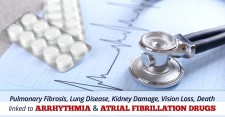
San Diego, CA, September 26, 2016 (Newswire.com) - With September coming to an end, Pulmonary fibrosis awareness month is also winding down. This does not mean this deadly disease should be left on the back burner. While it does not get the same levels of attention as many other diseases, its effects are just as devastating on families and individuals as many diseases that end up much more prominently in the news and receive a lot more funding and attention. For those who know little about the disease, Pulmonary fibrosis is a scarring in the lungs, and there is no cure. Over time, it turns into scar tissue known as fibrosis. Because of the disease, the lungs lose their ability to properly function making it hard to transport oxygen into the bloodstream and causing several symptoms.
About 40,000 people die each year in the United States from pulmonary fibrosis. About 50,000 new cases are diagnosed each year. Many people with the disease live only about three to five years after diagnosis.
"There is very little awareness of Pulmonary Fibrosis even though September is Pulmonary Fibrosis Awareness Month. It is disappointing when you contact newspapers and TV stations requesting reporting on pulmonary fibrosis awareness and get little to no response."
Alan Christopher, Consumer Safety Advocate
Pulmonary fibrosis is now the leading indication for lung transplantation in many large transplant centers.
According to Alan Christopher, a Consumer Safety Advocate at Consumer Safety Watch, "There is little awareness of Pulmonary Fibrosis among the general population with the exception of those who have dealt with its effects directly or indirectly, even though September is Pulmonary Fibrosis Awareness Month. It is disappointing when you contact newspapers and TV stations requesting reporting on pulmonary fibrosis awareness and get little to no response."
Pulmonary Fibrosis Diagnosis
Early diagnosis is key to helping manage this deadly disease. There is no single test capable of correctly diagnosing pulmonary fibrosis, which is why a group of diagnostic tests is often required to make a full diagnosis. Here’s a list of six ways to diagnose pulmonary fibrosis:
- Chest X-ray, which generates a picture of the chest structures such as the heart and lungs, allows physicians to search for shadows that indicate scar tissue.
- Breathing tests to find out how much lung damage you have. Lung function tests are also used to measure the amount and speed of air that can be blown out of the lung — which helps to understand the severity of damage in the lungs.
- Blood tests check for oxygen levels in your bloodstream and for possible infections. An arterial blood gas test is also used to measure the levels of oxygen and carbon dioxide by collecting and analyzing a sample of blood from an artery, usually in the wrist. The arterial blood gas test is considered to be more accurate than the pulse oximetry test.
- Lung biopsy, done during bronchoscopy or as a surgical procedure. A sample of lung tissue is removed for your doctor to study.
- CT scan: A high-resolution computed tomography (HRCT) scan is a type of x-ray with higher precision and more detail.
- During an exercise test, patients walk or pedal for a specific time while data is collected to reveal how the lungs move oxygen and carbon dioxide in and out of the bloodstream.
Some Causes of Pulmonary Fibrosis
- Cigarette smoking.
- Certain viral infections.
- Exposure to environmental pollutants, including silica and hard metal dusts, bacteria and animal proteins, and gases and fumes.
- The use of certain medicines including heart rhythm drugs Amiodarone, Pacerone, and Cordarone.
- Genetics
- ympGastroesophageal reflux disease (GERD).
Symptoms to look out for
- Shortness of breath
- Cough
- Breathing alterations
- Weight loss
- Fatigue
- Aching muscles and joints
- Clubbing (widening and rounding of the tips of the fingers or toes)
If you or a loved one is suffering symptoms of Pulmonary Fibrosis, it is important to seek medical attention as soon as possible.
For those interested in learning more about Pulmonary Fibrosis and its link to medications like Amiodarone, the generic name of several brand-name medications (Pacerone, Cordarone, and Aratac) that are used to treat irregular heart rhythm, atrial fibrillation, and atrial flutter please visit the Consumer Safety Watch website.
Source: Consumer Safety Watch
Share:
